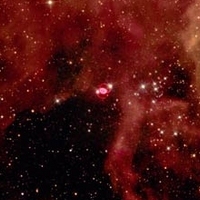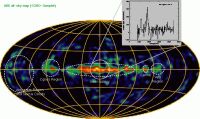Galactic
Interacting Binaries
Binary stars are pairs of stars sufficiently close to each other to be held together by their mutual gravitational attraction (like the Earth and the Moon), revolving in orbit around their common centre of gravity. Such pairs of stars are exceedingly common throughout the Universe.
 |
Many interacting binaries are thought to be black hole candidates, as their supposed masses seem to be greater than the mass attributed to neutron stars. One expects binaries to behave differently according to whether the compact object is a neutron star or a black hole. Thanks to the greatly improved observational instruments used by INTEGRAL, astrophysicists hope to be able to distinguish one from the other through their gamma-ray emissions, thus, proving the existence of black holes.
Galactic Centre
As astronomers obtained the first precise measurements of gamma radiation from the centre of our galaxy, the Milky Way, they were surprised to find a high density of gamma-ray sources. These objects, possibly related to interacting binaries, further puzzled astronomers by their constant variation of intensity. Even more mysterious is the object hiding in the heart of our galaxy. Images taken with radio telescopes of the centre of the Milky Way show a source called Sagittarius A* (Sgr A* in short), these images combined with a study of the velocity of stars near the centre indicates a hidden object of millions of solar masses, believed to be a massive black hole. But if Sgr A* is a black hole, it should, like other active nuclei emit X-rays and gamma-rays, contrary to the present evidence. The environment could explain this apparently weak activity. Up to now high energy radiation has never been detected from Sgr A*, possibly due to the lack of sensitivity of previous gamma-ray satellites. INTEGRAL will spend a lot of time scanning the centre of our galaxy, trying to detect these X-rays and gamma-rays, the last sign of matter swallowed by a black hole.
Galactic Plane
Some atomic nuclei, like uranium for example, are naturally radioactive, which means that they can at any time desintegrate and transform themselves into another atom. During this decay there is often a gamma photon emission at a very specific frequency, which corresponds to a sort of spectral fingerprint of the nucleus. This is what we call nuclear spectral line emission.
The observation of gamma-rays at this specific frequency, therefore, proves beyond doubt the presence of the atomic nucleus. Various nuclear spectral lines have been observed in the sky. One of the best known line is of a radioactive isotope of aluminum, Aluminum 26 (26Al).
|
Distribution of 26Al as seen by COMPTEL |
The 26Al has a lifetime of only about one million years, which is very short on the astronomical time scale. If we can detect it, its formation must, therefore, have taken place recently. 26Al and a lot of other complex atoms are formed inside "massive" stars, which have a very short lifetime, of a few million years, before they explode as a supernova. Because of the short lifetime of these stars, the distribution of 26Al in our galaxy indicates sites where stars were formed recently.
The INTEGRAL satellite will allow a finer analysis of this distribution and a better knowledge of star formation in our galaxy.
Supernovae
Stars emit a huge quantity of light, but like cars they have a fuel tank, which, when empty cannot be refilled. Consequently, they die. Small stars (less than 8 solar masses) die peacefully, unlike massive stars, which depart in a huge explosion called a supernova.
 |
|
SN1987A. Credit: Hubble Heritage Team (AURA/STSci/NASA). |
At the time of explosion the luminosity of the star increases by a factor of ten thousand. The supernova which took place in our galaxy in 1054 was visible in daylight. But supernovae generally occur at great distances from our Galaxy, except for one, called SN1987A, which exploded in 1987 in the Large Magellanic Cloud, a small galaxy near the Milky Way.
During a supernova explosion the energy density is so extreme that atoms already formed in the centre of the star, such as helium, carbon and oxygen, fuse and form new, more complex atoms. A large amount of these atoms are radioactive and emit gamma-rays.
One of these atoms is Cobalt 56, 56Co, detected in the supernova of 1987, SN1987A. INTEGRAL will observe supernovae in the vicinity of our galaxy to measure the quantity of elements formed during the explosion, enabling us to better understand the explosion mechanism.
Neutron Stars
When a massive star explodes, not all the material is ejected into space. Some of it collapses to form an extremely compact object: a neutron star or a black hole. A neutron star is a body of about the same mass as our Sun but with a radius of only 10 kilometres. Matter in a neutron star is so compressed that one drop of it would weigh millions of tonnes on Earth. Gravitation crushes protons and electrons together despite their electrostatic repulsion. A neutron star is therefore a huge atomic nucleus essentially constituted of neutrons.
A neutron star can sometimes possess an intense magnetic field, which can also accelerate particles and cause them to emit gamma rays.
Neutron stars can have a maximal mass of 2 to 3 times the mass of the Sun. Beyond this critical mass, the internal pressure against gravitational collapse is no longer sufficient and the star becomes a black hole. Nothing, not even light, can escape from a black hole.
Virtually all types of compact objects are significant sources of high-energy emission because the enormous gravitational field accelerates matter close by to extreme velocities. The fast particles emit gamma radiation. INTEGRAL will image the compact objects with unprecedented detail at high energies and the spectroscopic capabilities of the mission will provide the first detailed physical diagnostics of these systems at gamma-ray energies.
Many riddles remain to be solved. For example, on 27 August 1998 a powerful flash of gamma rays turned night into day in the Earth's outer atmosphere. The flash was caused by a distant neutron star with an extremely strong magnetic field: a magnetar. Are there really millions of magnetars in our Galaxy, as many scientists think? INTEGRAL will gather more data about these strange compact objects.

